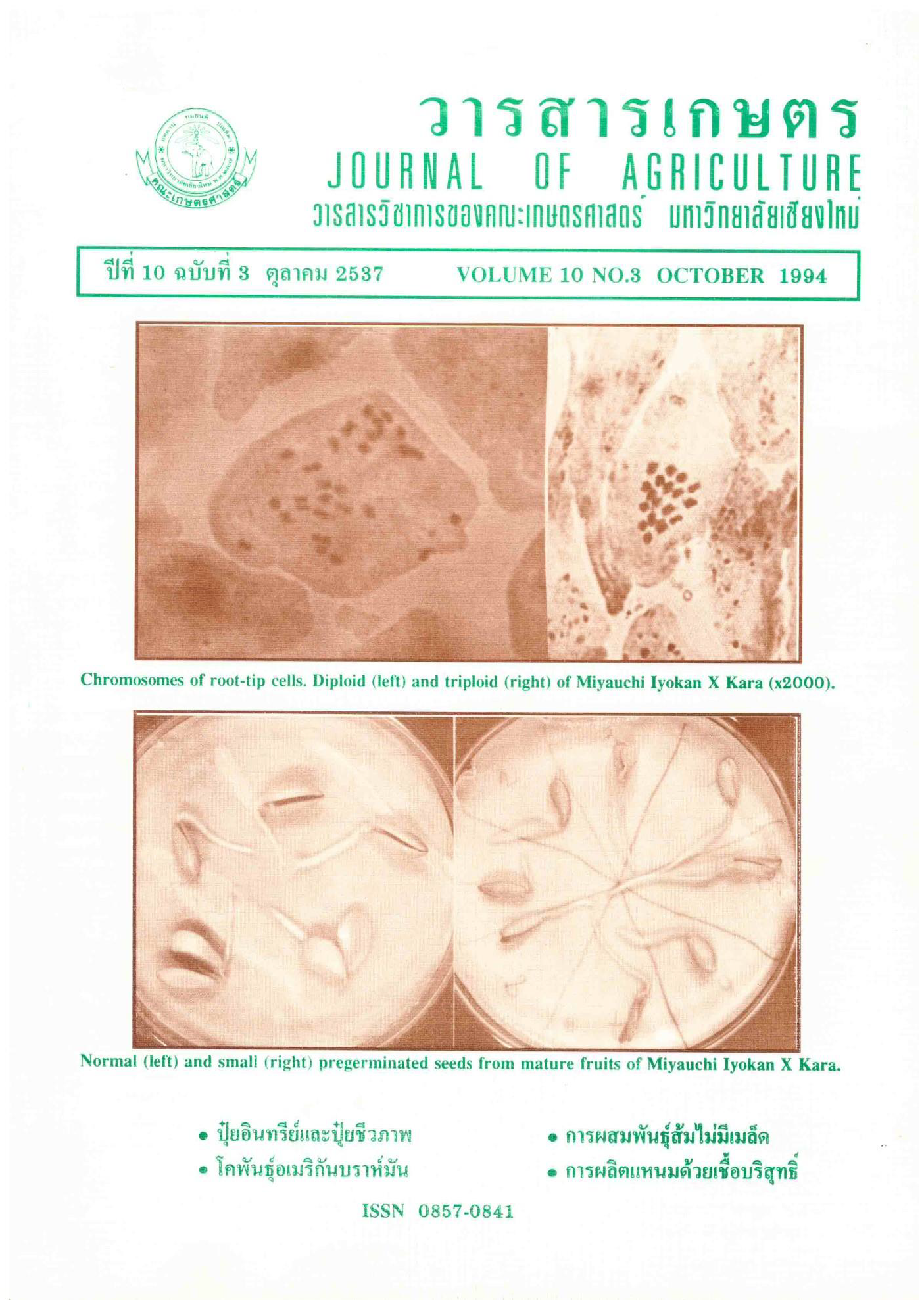การพัฒนาสายพันธุ์ส้มไม่มีเมล็ดโดยวิธีการผสมพันธุ์
Main Article Content
บทคัดย่อ
การผลิตสายพันธุ์ส้มธุ์ส้มไม่มีเมล็ด (triploid, 3x=X27) สามารถกระทำได้โดยการผสมพันธุ์จาก ส้มลูกผสม (Tangor-Miyauchi Iyokan) และส้มที่มีผลคล้ายส้มโอ (Hyuganatsu) เป็นแม่พันธุ์และส้มลูกผสมต่างๆ (Tangelo-Minneola, hybrid mandarin-Kara, hybrid orange-Nova) แต่พ่อพันธุ์ ปรากฎว่าคู่ผสม Miyauchi Iyokan X Kara ให้ต้นกล้าส้มลูกผสมที่เป็น triploid 80%, Miyauchi Iyokan X Minneola 29.41%, Hyuganatsu X Nova 28.60%, Hyuganatsu X Minneola 25%, Miyauchi Iyokan X Nova 20% ของจำนวน ต้นกล้าที่ได้จากเมล็ดส้มขนาดเล็ก และมีคู่ผสมเดียว (Hyuganatsu X Kara) ที่ไม่สามารถผลิตต้นกล้าส้มลูกผสมที่เป็น triploid ได้
Article Details
ประเภทบทความ
บทความวิจัย
เอกสารอ้างอิง
1. พิชิต ตุลพงศ์. (2737). การสร้างสายพันธุ์ส้มไม่มีเมล็ดจากเมล็ดส้มขนาดเล็กที่มีหลายคัพภะ. การสัมมนาวิชาการประจำปี 2537 สมาคมนักเรียนไทยในประเทศญี่ปุ่นในพระบรมราชูปถัมภ์ 11 ธันวาคม 2537 ณ หอพักนักเรียนนานาชาติ กรุงโตเกียว ประเทศญี่ปุ่น. หน้า 117.
2. Esen, A. (1971). Unexpected polyploids in Citrus and their origin. Ph.D. Dissertation, Uni. of California, Riverside, California.
3. Esen, A. and R. K. Soost. (1971). Unexpected triploids in Citrus: Their origin, identification, and possible use. J. Hered. 62: 329-333.
4. Frost, H. B. (1925). The chromosomes of citrus. J. Wash. Acad. Sci. 15: 1-3.
5. Gmitter, F. G., Jr. and X. B. Ling. (1991). Embryogenesis in vitro and nonchimeric tetraploid plant recovery from undeveloped citrus ovules treated with colchicine. J. Amer. Soc. Hort. Sci. 116: 317-321.
6. Gmitter, F. G., Jr., X. B. Ling, and X. X. Deng. (1990). Induction of triploid citrus plants from endosperm calli in vitro. Theor. Appl. Genet. 80: 785-790.
7. Grosser, J. W., F. G. Gmitter, Jr., F. Sesto, X. X. Deng, and J.L. Chandler. (1992). Six new somatic citrus hybrids and their potential for cultivar improvement. J. Amer. Soc. Hort. Sci. 117: 169- 173.
8. Hearn, C. J. (1984). Development of seedless orange and grapefruit cultivars through seed irradiation. J. Amer. Soc. Hort. Sci. 109: 270-273.
9. Iwamasa, M. (1966). Studies on the sterility in genus Citrus with special reference to the seedlessness. Bull. Hort. Res. Stn., Minist. Agri. Forest. and Fisheries. B 6: 1-81.
10. Krezdorn, A. H. and M. Cohen. (1962). The influence of chemical fruit-set sprays on yield and quality of citrus. Proc. Fla. State Hort. Soc. 75: 53-60.
11. Love, A. and D. Love. (1975) Plant science 1: Plant chromosomes. Strauss & Cramer, Leutershausen, Germany. 184 pp.
12. Nito, N. and M. Iwamasa. (1985). Abnormal anther develolpment in 'Sweet Spring’ and ‘Kara’ , hybrid progenies of satsuma mandarin. Bull. Fac. Agri., Saga Uni. 59: 11-16.
13. Nito, N. and M. Iwamasa. (1986). Development of pollen grain of Citrus at anthesis. Bull Fac. Agri., Saga Uni. 60: 1-7.
14. Oiyama, I. and N. Okudai. (1983) .Studies on the polyploidy breeding in Citrus. III. Occurrence of triploids in the progenies of diploid sweet oranges crossed with diploids. Bull. Fruit Tree Res. Stn. D 5: 1-8.
15. Plaut, N. (1947). Experiments with unfruitful valencia orange trees. Palestine J. Bot. 6:58-62.
16. Soost, R. K. (1958). Gibberellic acid on mandarin. Calif. Agri. 12: 5.
17. Toolapong, P. (1994). Triploids and aneuploids in citrus fruits. D.Sc. Dissertation, Kyushu Tokai University, Kumamoto, Japan.
18. Toolapong, P., H. Komatsu and M. Iwamasa. (1995a). Triploids and haploid from small seeds of ‘Banpeiyu’ , a pummelo cultivar, crossed with grapefruit. J. Jap. Soc. Hort. Sci. (In press).
19. Toolapong, P., H. Komatsu and M. Iwamasa. (1995b). Triploids from small seeds of polyembryonic citrus cultivars. Proc. Sch. Agri. Kyushu Tokai University. 14: 1-8.
20. Zhang, W. (1985). Citrus clonal selection, progeny testing and in vitro propagation. J. Fruit Var. 39: 20-30.
2. Esen, A. (1971). Unexpected polyploids in Citrus and their origin. Ph.D. Dissertation, Uni. of California, Riverside, California.
3. Esen, A. and R. K. Soost. (1971). Unexpected triploids in Citrus: Their origin, identification, and possible use. J. Hered. 62: 329-333.
4. Frost, H. B. (1925). The chromosomes of citrus. J. Wash. Acad. Sci. 15: 1-3.
5. Gmitter, F. G., Jr. and X. B. Ling. (1991). Embryogenesis in vitro and nonchimeric tetraploid plant recovery from undeveloped citrus ovules treated with colchicine. J. Amer. Soc. Hort. Sci. 116: 317-321.
6. Gmitter, F. G., Jr., X. B. Ling, and X. X. Deng. (1990). Induction of triploid citrus plants from endosperm calli in vitro. Theor. Appl. Genet. 80: 785-790.
7. Grosser, J. W., F. G. Gmitter, Jr., F. Sesto, X. X. Deng, and J.L. Chandler. (1992). Six new somatic citrus hybrids and their potential for cultivar improvement. J. Amer. Soc. Hort. Sci. 117: 169- 173.
8. Hearn, C. J. (1984). Development of seedless orange and grapefruit cultivars through seed irradiation. J. Amer. Soc. Hort. Sci. 109: 270-273.
9. Iwamasa, M. (1966). Studies on the sterility in genus Citrus with special reference to the seedlessness. Bull. Hort. Res. Stn., Minist. Agri. Forest. and Fisheries. B 6: 1-81.
10. Krezdorn, A. H. and M. Cohen. (1962). The influence of chemical fruit-set sprays on yield and quality of citrus. Proc. Fla. State Hort. Soc. 75: 53-60.
11. Love, A. and D. Love. (1975) Plant science 1: Plant chromosomes. Strauss & Cramer, Leutershausen, Germany. 184 pp.
12. Nito, N. and M. Iwamasa. (1985). Abnormal anther develolpment in 'Sweet Spring’ and ‘Kara’ , hybrid progenies of satsuma mandarin. Bull. Fac. Agri., Saga Uni. 59: 11-16.
13. Nito, N. and M. Iwamasa. (1986). Development of pollen grain of Citrus at anthesis. Bull Fac. Agri., Saga Uni. 60: 1-7.
14. Oiyama, I. and N. Okudai. (1983) .Studies on the polyploidy breeding in Citrus. III. Occurrence of triploids in the progenies of diploid sweet oranges crossed with diploids. Bull. Fruit Tree Res. Stn. D 5: 1-8.
15. Plaut, N. (1947). Experiments with unfruitful valencia orange trees. Palestine J. Bot. 6:58-62.
16. Soost, R. K. (1958). Gibberellic acid on mandarin. Calif. Agri. 12: 5.
17. Toolapong, P. (1994). Triploids and aneuploids in citrus fruits. D.Sc. Dissertation, Kyushu Tokai University, Kumamoto, Japan.
18. Toolapong, P., H. Komatsu and M. Iwamasa. (1995a). Triploids and haploid from small seeds of ‘Banpeiyu’ , a pummelo cultivar, crossed with grapefruit. J. Jap. Soc. Hort. Sci. (In press).
19. Toolapong, P., H. Komatsu and M. Iwamasa. (1995b). Triploids from small seeds of polyembryonic citrus cultivars. Proc. Sch. Agri. Kyushu Tokai University. 14: 1-8.
20. Zhang, W. (1985). Citrus clonal selection, progeny testing and in vitro propagation. J. Fruit Var. 39: 20-30.


